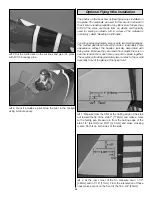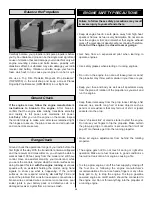
❏
1. Turn on the transmitter and receiver and center the
trims. If necessary, remove the servo arms from the servos
and reposition them so they are centered. Reinstall the
screws that hold on the servo arms.
❏
2. With the transmitter and receiver still on, check all the
control surfaces to see if they are centered. If necessary, adjust
the clevises on the pushrods to center the control surfaces.
❏
3. Make certain that the control surfaces and the
carburetor respond in the correct direction as shown in the
diagram. If any of the controls respond in the wrong direction,
use the servo reversing in the transmitter to reverse the
servos connected to those controls. Be certain the control
surfaces have remained centered. Adjust if necessary.
Use a Great Planes AccuThrow
™
(or a ruler) to accurately
measure and set the control throw of each control surface as
indicated in the chart that follows. If your radio does not
have dual rates, we recommend setting the throws at the low
rate setting.
Note: The throws are measured at the widest part of the
elevators, rudder and ailerons.
At this stage the model should be in ready-to-fly condition with
all of the systems in place including the engine, landing gear,
covering, and the radio system. The P-6E Hawk ARF is a
short-coupled airplane, making it nearly impossible to
balance without the addition of some nose weight. Earlier you
assembled a box to hold lead. Remove the spinner and cowl.
Attach the weight box to the top of the firewall box using epoxy
and #4 x 1/2" sheet metal screws. Remove the cover from the
box and install lead. Great Planes (GPMQ4485) “stick-on”
lead works well. All of our prototypes had an O.S.
®
1.20 four-
stroke engine and required approximately 16 oz. of lead. This
should be a good starting point for balancing your plane too.
After putting the lead in the box be sure to re-install the cowl,
spinner and propeller. After you install nose weight, pack the
inside of the box tight with foam rubber to prevent any lead
from coming loose and rattling around inside the box.
More than any other factor, the C.G. (balance point) can
have the greatest effect on how a model flies, and may
determine whether or not your first flight will be
successful. If you value this model and wish to enjoy it for
many flights, DO NOT OVERLOOK THIS IMPORTANT
PROCEDURE. A model that is not properly balanced will
be unstable and possibly unflyable.
Balance the Model (C.G.)
IMPORTANT: The P-6E Hawk ARF has been extensively
flown and tested to arrive at the throws at which it flies
best. Flying your model at these throws will provide you
with the greatest chance for successful first flights. If, after
you have become accustomed to the way the P-6E Hawk
ARF flies, you would like to change the throws to suit your
taste, that is fine. However, too much control throw could
make the model difficult to control, so remember, “more is
not always better.”
These are the recommended control surface throws:
High Rate
Low Rate
ELEVATOR:
1" [25mm] up
3/4" [19mm] up
1" [25mm] down
3/4" [19mm] down
AILERONS:
1-1/4" [32mm] up
3/4" [19mm] up
1-1/4" [32mm] down 3/4" [19mm] down
RUDDER:
1-3/4" [44mm] right
1-1/4" [32mm] right
1-3/4" [44mm] left
1-1/4" [32mm] left
Set the Control Throws
CARBURETOR WIDE OPEN
RUDDER MOVES RIGHT
LEFT AILERON MOVES DOWN
RIGHT AILERON MOVES UP
ELEVATOR MOVES UP
4-CHANNEL
TRANSMITTER
(STANDARD MODE 2)
4-CHANNEL RADIO SETUP
TRANSMITTER
4-CHANNEL
TRANSMITTER
4-CHANNEL
TRANSMITTER
4-CHANNEL
Check the Control Directions
GET THE MODEL READY TO FLY
30







































